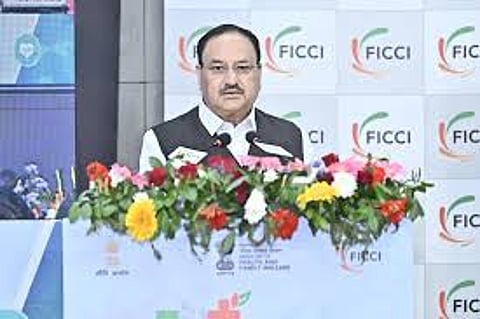

Union Health Minister JP Nadda announced the government’s renewed commitment to strengthening India’s health care system at the FICCI HEAL 2025 event in New Delhi on October 9. He emphasized that the focus is on making health services affordable, accessible, and efficient for all citizens. Over the past decade, India’s health sector has undergone transformative reforms centered on prevention, access, and long-term wellness.
Nadda noted that the National Health Policy 2017 marked a major shift in the country’s health care approach — the first policy update since 1998. “Previously, we focused only on curing diseases,” he said. “But after 2017, we began thinking about comprehensive health care that includes prevention, early detection, and overall wellness.”
The 2017 policy framework prioritizes five pillars of care — preventive, promotive, palliative, curative, and geriatric. This holistic model not only focuses on treatment but also empowers citizens to lead healthier lives. Nadda highlighted the importance of preventive care, explaining that early detection saves lives and significantly reduces long-term health care costs.
To strengthen primary care delivery, the government has established 1.7 lakh Ayushman Arogya Mandirs across India. These centers provide free basic medical services, routine checkups, and health counseling, with a focus on reaching remote and rural communities.
Progress in maternal and child health has also been notable. According to the National Family Health Survey, institutional deliveries have increased from 79% to 90%, leading to a sharp decline in the Maternal Mortality Ratio (MMR) — from 130 deaths per lakh live births to 88. Nadda called this improvement a “major public health milestone” for the country.
He also highlighted the success of the Ayushman Bharat scheme, describing it as the world’s largest health coverage program. The initiative currently benefits over 62 crore citizens, covering nearly 40% of India’s population. Each eligible family receives health insurance coverage of up to ₹5 lakh per year. Recently, new provisions were added for citizens aged 70 and above, ensuring better elderly care.
To ensure affordable medicines, the government launched the Jan Aushadi scheme, offering high-quality drugs at low prices through a network of dedicated outlets. “This initiative ensures that health care remains affordable for every income group,” Nadda said.
Additionally, the government has reduced GST on medicines and health insurance, further lowering the financial burden of medical treatment and coverage. This step aligns with India’s broader goal of achieving universal and equitable health care.
Experts at the FICCI event commended these policy directions, noting that India’s model — emphasizing preventive care, affordability, and accessibility — could serve as a blueprint for other developing nations.
In conclusion, Nadda reaffirmed the government’s vision to build a strong, inclusive, and resilient health system through initiatives like Ayushman Bharat, Jan Aushadi, and Ayushman Arogya Mandirs. By focusing on prevention, innovation, and early detection, India is moving steadily toward the goal of universal health coverage and a healthier future for all.
Also Read